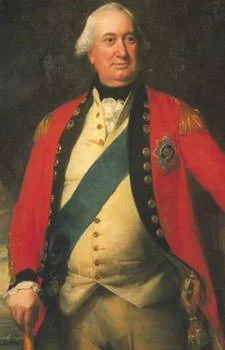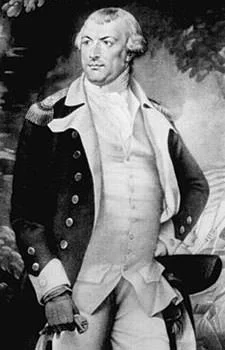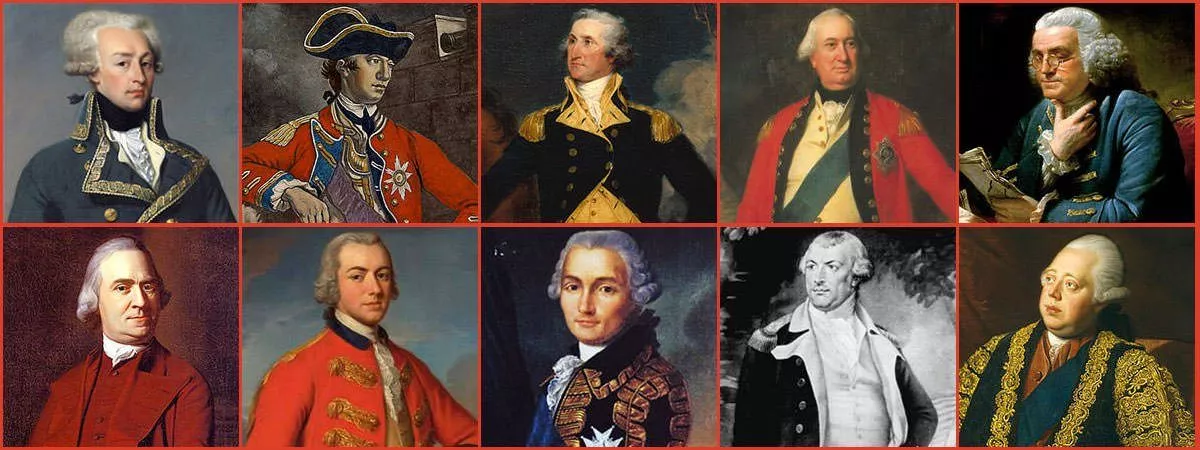The American Revolution was a revolt in the Thirteen British Colonies in North America which lasted from 1765 to 1783. After conflict between Great Britain and its colonies on several issues, most prominently taxation without representation; the American Revolutionary War broke out in 1775. During the war, the Continental Army defeated the British leading to the formation of the United States of America. There were several influential leaders during the course of the American Revolution. Samuel Adams was a key figure in the early phase of the revolution who forcefully opposed taxation and organized protests. Once war broke out, George Washington led the Continental Army and he was supported by many able officers including Nathanael Greene. On the British side, Frederick North was the prime minister during most of the revolution. The post of the Commander-in-Chief of the British Army in America was held by four people during the war. The most prominent among these were William Howe and Henry Clinton. Together these two led the British troops through most of the revolutionary war. Here are the 10 major military and political leaders of the American Revolution.
#1 Frederick North, 2nd Earl of Guilford
| Lifespan: | April 13, 1732 – August 5, 1792 |
| Nationality: | British |

Frederick North, better known as Lord North, was the Prime Minister of Great Britain from 1770 to 1782. It was the Parliament which held true power in Great Britain and thus Lord North led his nation through most of the American Revolution. The American colonies were dissatisfied about taxation without representation, that is being taxed by a British Parliament to which they elected no representatives. This conflict led to the Boston Tea Party in 1773, an event in which Bostonians dumped 342 chests of tea, worth £10,000, into into the Boston Harbor. Lord North responded to this by implementing a number of legislative measures to punish the Bostonians. He thought that this would dispirit the rebellious colonists but instead it led to open war between the two sides with the Battles of Lexington and Concord in 1775. After France joined the conflict on the side of the Americans in 1778, the conflict escalated to other regions, compounding troubles for Lord North. He saw little benefit in continuing the conflict and attempted to resign, but King George III rejected both his proposals. However, the decisive victory of the Americans at Yorktown ultimately forced the king to accept North’s resignation in 1782 as well as to end offensive operations in America.
#2 Samuel Adams
| Lifespan: | September 27, 1722 – October 2, 1803 |
| Nationality: | American |

Born in Boston, Samuel Adams was elected to the Massachusetts assembly in 1764. The British Parliament passed the Stamp Act the following year imposing direct taxes on the colonies for the first time. Samuel Adams denounced the Act and was one of the first to oppose taxation without representation. Moreover, through his writing, he urged fellow Bostonians to resist what he termed were illegal actions of the British Parliament. In May 1773, the British Parliament passed the Tea Act, which allowed East India Company to sell tea in American colonies without paying taxes. By then, Adams had assumed leadership of the Massachusetts radicals and it was he who, more than anyone else, planned the Boston Tea Party in 1773. When the Revolutionary War began, Adams played a leading role in the Continental Congress and pushed for complete independence. Samuel Adams was a key figure in the early phase of the American Revolution. He was a master at organizing protests and he also spread the cause of the revolution through his writings. After the United States achieved independence, Adams went on to serve as Governor of Massachusetts from 1794 to 1797.
#3 George Washington
| Lifespan: | February 22, 1732 – December 14, 1799 |
| Nationality: | American |

When the American Revolutionary War broke out in 1775, Congress created the Continental Army and George Washington was appointed as its Commander-In-Chief. Washington took enormous duties during the war. He plotted the overall strategy of the war along with the Congress. He organized and trained the army and maintained their morale. Most importantly his stature as well as his political and personal skill was instrumental to make the Congress, the army, the French and the states work towards a common goal. Washington actively led his men against the main British forces in 1775 – 77 and then again in 1781. Though he lost battles he never surrendered his army during the war. When the British had handed the Americans a number of major defeats and most had thought that the cause was lost, it was Washington who laid out a bold plan, crossed the ice choked Delaware River and handed the British a defeat at the Battle of Trenton. Victory at Trenton greatly boosted the morale in the colonies and led to new recruits joining the forces. Moreover, he also led the American force that defeated a British army commanded by Lord Cornwallis at the decisive Battle of Yorktown. After the Revolutionary War, Washington went on to serve as the first president of the United States from 1789 to 1797.
#4 William Howe
| Lifespan: | August 10, 1729 – July 12, 1814 |
| Nationality: | British |

In September 1775, William Howe took over as Commander-in-Chief of the British Army in America. The American Revolutionary War had just begun then and Boston was under siege. Howe planned to establish base in New York and Newport, Rhode Island in an attempt to isolate the rebellion to New England. The British forces thus evacuated Boston on March 17, 1776. On August 22, a British force under Howe landed on the south beaches of Long Island. What followed was a series of victories for the British which drove the Continental Army completely out of New York and to retreat through New Jersey and into Pennsylvania. Howe then embarked on a campaign toward Philadelphia, then the American capital. He defeated the Americans at the Battle of Brandywine on September 11, 1777. This left Philadelphia vulnerable. Howe captured the American capital two weeks later on September 26. However, his taking of Philadelphia contributed to the failure of General John Burgoyne’s Saratoga campaign. The Battles of Saratoga were a disaster for the British as Burgoyne had to surrender his entire army on October 17. More importantly, the comprehensive victory gave France the confidence that America could win the war and this resulted in the formal Franco-American alliance. Howe submitted his recognition in October 1777 and it was accepted in April 1778.
#5 Henry Clinton
| Lifespan: | April 16, 1730 – December 23, 1795 |
| Nationality: | British |

First arriving in Boston in May 1775, Henry Clinton had served as the second in command to Howe. He replaced Howe as the Commander-in-Chief of the British Army in America in May 1778. The Northern strategy of the British had failed due to the Battles of Saratoga and, after taking command, Clinton evacuated their troops from Philadelphia back to New York City in 1778 to strengthen the city’s defense against a possible Franco-American attack. Clinton then conducted the successful Siege of Charleston from March 29, 1780 to May 12, 1780. The American losses after the siege were 89 killed, 138 wounded and 5,466 captured. The Siege of Charleston was one of the worst American defeats of the war. After capturing Charleston, the British drove the remaining Continental Army troops from South Carolina by May 29, thus strengthening their hold in the South. After capturing Charleston, Henry Clinton returned to New York, leaving the command in the south to Lord Charles Cornwallis. Miscommunication and disagreement between Clinton and both Cornwallis and Admiral Marriot Arbuthnot contributed to British failures that culminated in the 1781 Siege of Yorktown. The siege, which lasted for 20 days, resulted in Cornwallis surrendering his entire force of more than 7,000. It was the last major battle of the American Revolutionary War as it forced the British to negotiate an end to the conflict. In 1782, after fighting in the North American theater also ended due to Yorktown, Clinton was replaced as Commander-in-Chief by Guy Carleton.
#6 Jean-Baptiste Donatien de Vimeur, comte de Rochambeau
| Lifespan: | July 1, 1725 – May 10, 1807 |
| Nationality: | French |

Comte de Rochambeau was the Commander-In-Chief of the French Expeditionary Force that embarked from France in order to help the American Continental Army fight against British forces. Though he arrived in 1779, he was largely inactive for a year due to the successful British blockading of Rhode Island’s ports. On July 6, 1781 the French and American armies met near New York City. Although Rochambeau had almost 40 years of warfare experience, he told Washington that he had come to serve and not to command and he never challenged Washington’s authority. Washington and Rochambeau then marched their combined forces to the Siege of Yorktown. There their troops met with the troops of Marquis de Lafayette to conduct the successful siege. It resulted in the surrender of the entire army of Lord Charles Cornwallis and was the decisive battle of the American Revolutionary War. After the siege, Rochambeau remained to garrison the southern states until 1783. Upon his return to France, Rochambeau was honored by King Louis XVI and was made governor of the province of Picardy.
#7 Gilbert du Motier, Marquis de Lafayette
| Lifespan: | September 6 1757 – May 20, 1834 |
| Nationality: | French |

With the aim of winning glory as a soldier, Lafayette, traveled at his own expense to the American colonies. With no combat experience and not yet 20 years old, he arrived in Philadelphia in July 1777. On August 5, 1777, he met General George Washington and the two would go on to establish a father-son relationship. The first battle he participated in was the Battle of Brandywine, during which he was wounded but still managed to organize an orderly retreat. As he fought with distinction during the battle, he was given command of his own division. He went on to fight in a number of battles including at Barren Hill, Monmouth and Rhode Island. At Barren Hill, despite being massively outnumbered, he conducted a masterly retreat on May 28, 1778. In 1799, Lafayette left for home to lobby for an increase in French support. The following year, he returned to America and was given senior positions in the Continental Army. He went on to serve with distinction in several more battles. However, his most important contribution came in 1781, when troops under his command in Virginia trapped Cornwallis until other American and French forces could position themselves for the decisive Siege of Yorktown. After returning to his homeland, Marquis de Lafayette went on to play an important role in the French Revolution including help write the Declaration of the Rights of Man and of the Citizen.
#8 Charles Cornwallis
| Lifespan: | December 31, 1738 – October 5, 1805 |
| Nationality: | British |

Charles Cornwallis began service in North America in 1776 under Henry Clinton in the failed Siege of Charleston. He then participated in the successful New York and New Jersey campaign under Commander-In-Chief William Howe. Cornwallis then continued to serve under Howe as the British took control of Philadelphia. He played a leading role in several battles of the campaign including the Battle of Brandywine and the Battle of Germantown. After Henry Clinton became Commander-In-Chief, Cornwallis became his second in command. Along with Clinton, he led the British forces in the successful second siege of Charleston in 1780. After the siege, Clinton left for New York leaving Cornwallis in command of the south. Post Charleston, Cornwallis began to advance to North Carolina but, after the decisive defeat at the Battle of Kings Mountain, he was forced to retreat back into South Carolina. The Americans reconquered South Carolina from the British. Conrwallis was then trapped at Virginia with the French fleet defeating the Royal Fleet at the Battle of the Chesapeake. After non-stop bombardment from Franco-American forces, no hope of reinforcements and inadequate supplies of artillery ammunition and food, Cornwallis showed the white flag on October 17, 1781. The unpleasant relationship between Cornwallis and Clinton has been cited as a major cause of the British defeat. After the Revolutionary War was over, Charles Cornwallis went on to serve as Governor-General and commander-in-chief in India.
#9 Nathanael Greene
| Lifespan: | August 7, 1742 – June 19, 1786 |
| Nationality: | American |

After the American Revolutionary War broke out in April 1775, the legislature of Rhode Island established an army and appointed Nathanael Greene to command it. The same year, he became a general in the newly-established Continental Army. Greene served with distinction under General Washington in the Boston; New York and New Jersey; and the Philadelphia campaigns. In October 1780, after the Americans had suffered a series of devastating defeats in the South under the command of Benjamin Lincoln and Horatio Gates; Nathanael Greene was appointed as the commander of the Continental Army in the southern theater. After taking command, Greene employed guerrilla warfare tactics successfully against the numerically superior British forces led by Charles Cornwallis. He inflicted heavy losses on the British at battles of Guilford Court House; Hobkirk’s Hill; and Eutaw Springs. He was thus instrumental in the in the success of the Continental Army in the southern theater. After the decisive Siege of Yorktown, Greene continued to serve in the Continental Army until late 1783. Nathanael Greene emerged from the war as the most gifted and dependable officer under George Washington. Among other things, he is widely regarded as one of the best strategists in the Continental Army.
#10 Benjamin Franklin
| Lifespan: | January 17, 1706 – April 17, 1790 |
| Nationality: | American |

When the Revolutionary War began, Benjamin Franklin was unanimously elected by the Pennsylvania Assembly as their delegate to the Second Continental Congress, which was a convention of representatives from the Thirteen Colonies to manage their war efforts against Britain. It decided to issue a declaration of independence and Franklin was one of the five members who were appointed to draft it. Though much of it is written by Thomas Jefferson, Franklin made several important changes. The U.S. Declaration of Independence, announcing that the colonies regarded themselves as independent sovereign states, was adopted on July 4, 1776. In December 1776, Franklin was sent to France as the first U.S. Ambassador. He was much admired in France; and played a prominent role in the development of positive relations between America and France. He negotiated a permanent military alliance with France in early 1778. French assistance was instrumental in the victory of the American colonies over Great Britain. The efforts of Benjamin Franklin thus proved vital in the American Revolution. Franklin was also one of the representatives from U.S. who signed the Treaty of Paris in 1783, which, among other things, brought the war to an end and made Britain acknowledge U.S. colonies as free, sovereign and independent states. In independent America, Franklin served as the sixth Governor of Pennsylvania from 1785 to 1788.

